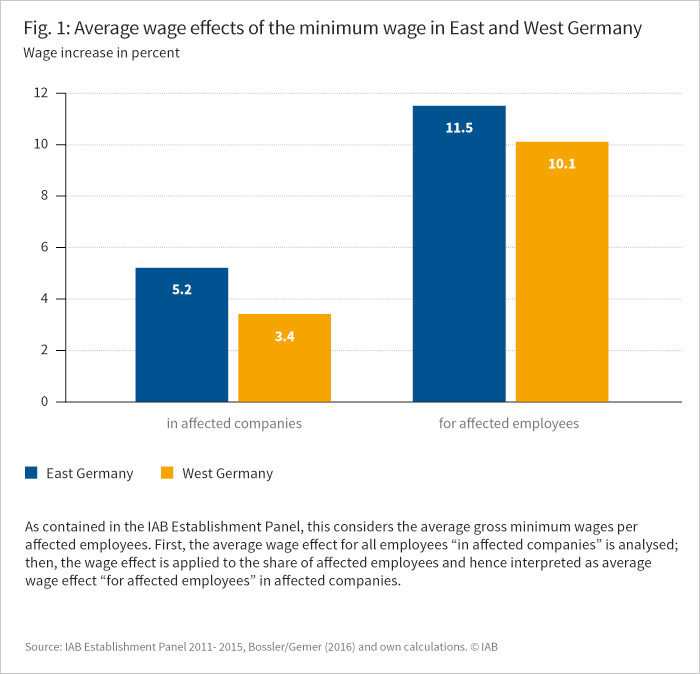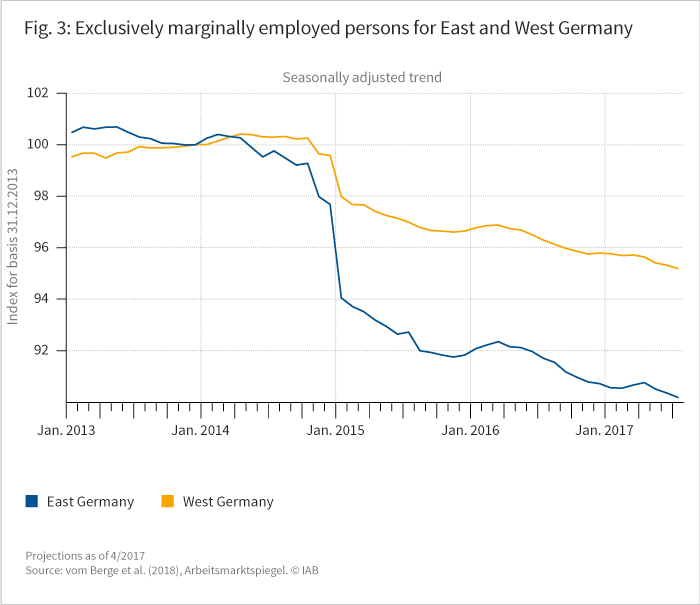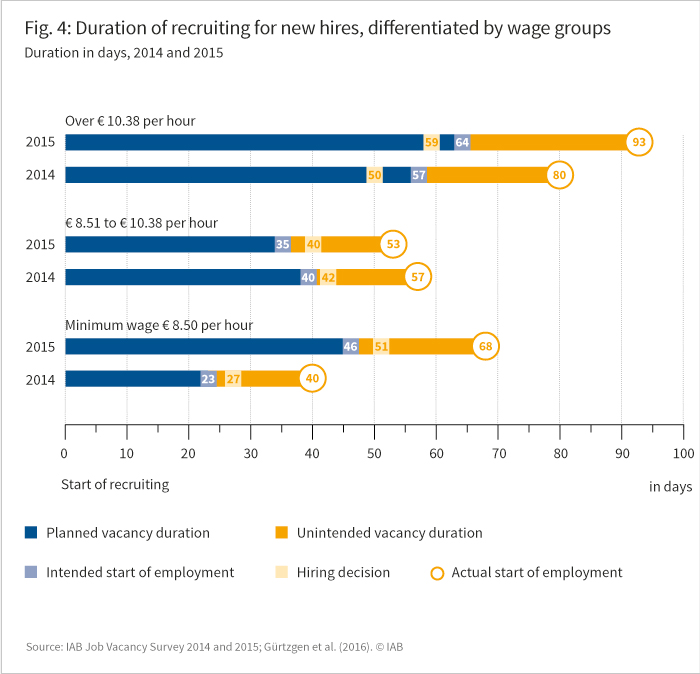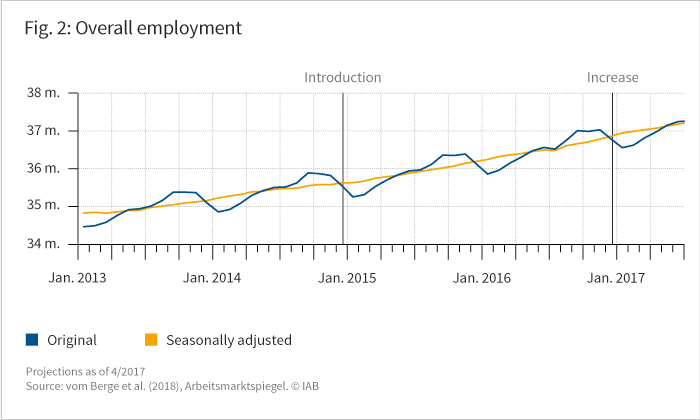6. August 2018 | Wages and Employment
The German labour market after the introduction of the statutory minimum wage
Mario Bossler , Johanna Eberle , Nicole Gürtzgen , Wolfram Klosterhuber , Philipp vom Berge

The impact intensity of the minimum wage
The impact intensity of the minimum wage – that is, the extent to which it impacts on the existing wage structure – is crucial in terms of the potential pay and employment effects induced by the minimum wage. Only if employees benefit from wage increases to a significant extent, a measurable decline in wage inequality can be expected. Similarly, businesses will only adapt their behaviour if their wage costs climb noticeably due to the minimum wage. There are two methods for measuring impact intensity: first, the proportion of affected employees, which provides an estimate of the extent to which employees are within the scope of the minimum wage. A second aspect is the magnitude of wage adjustments, i.e. the average wage increase which is necessary so reach the minimum wage.
Both factors determine the extent to which low earners may enjoy a higher hourly wage due to the minimum wage. However, workers affected by the minimum wage may not necessarily benefit from a wage increase; the minimum wage can also lead to job losses – especially in cases where the minimum wage exceeds the original wage which was paid according to employees’ productivity.
When a share of affected employees loses their job through the minimum wage, the number of affected employees can exceed the number of employees who have benefited from it. Conversely, the number of benefiting employees can also be larger than the number of affected employees. This may be the case if wages are pre-emptively raised before the introduction of the minimum wage. These people would not be defined as directly affected, but are still benefiting from the minimum wage. On the other hand, it is also possible that even people who are not within direct scope of the minimum wage benefit from it – namely in cases where companies, due to the introduction of a minimum wage, raise those wages which already lay above the €8,50 threshold, in order to preserve the pay scale between employee groups within the company.
Shares of employees who are either affected by or benefiting from the minimum wage
According to data from the IAB Establishment Panel, the share of workers affected by the minimum wage who work in companies with at least one socially insured employee was around 4.2 per cent nationwide in the third quarter of 2014. In the west, the share was comparatively low at about 2.9 percent; in eastern Germany it was more than twice as high at 10.6 percent. The Federal State level shows similar differences between East and West: while the States in eastern Germany exhibit a relatively high proportion of affected employees, the proportion is much lower in all western German States, especially in the south.
A similar picture is apparent for the share of employees who benefit from the minimum wage. In total, 6.2 percent of employees in Germany received a pay increase thanks to the minimum wage. This extrapolates to approximately 2.3 million employees (companies that do not have any employees subject to social security contributions are excluded). The proportion in eastern German Federal states lies at an average of 13.4 percent, which is well above the western average of 4.6 percent.
Average wage increases as a result of the minimum wage
Figure 1 represents average wage increases which were triggered by the minimum wage. In companies which were affected (i.e. with at least one employee affected by the minimum wage), the average gross monthly wage increase due to the minimum wage is on average 5.2 percent in eastern Germany and 3.4 percent in western Germany.

On the other hand, if one considers the average increase in wages for a worker affected by the minimum wage, their wage-increase amounted to 11.5 percent in East Germany and 10.1 percent in West Germany. Thus, the monthly wage of a worker affected by the minimum wage increased significantly as a result of the introduction of the minimum wage.
The development of overall employment
In view of the clearly perceptible impact intensity of the minimum wage, the question naturally arises as to how overall employment developed after its introduction. Information about this can be obtained from the “IAB Labour Market Survey” (see info box). Overall, the introduction of the statutory minimum wage coincided with a period of robust economic growth of 1.7 percent in 2015. This is likely to have contributed to a consistently strong increase in total employment in Germany in the year of the introduction of the statutory minimum wage and in subsequent years (see Figure 2).
In contrast to the consistently positive overall employment trend, marginal employment declined significantly due to the minimum wage . The seasonally adjusted number of individuals working in marginal employment fell by around 93,000 at the turn of the year 2014/2015. After this first clear reaction, there is another moderately declining trend until the end of the first quarter of 2017.
Marginal employment is often converted into employment subject to social security contributions
The decline in marginal employment, with overall employment remaining positive, indicates that at least part of the marginal employment has been converted into standard employment which is subject to social security contributions. Comparing the number of exits from exclusively marginal employment at the time of the introduction of the minimum wage in January 2015 with the previous year and the years thereafter, and breaking these exits down into the forms of employment or non-employment which the individuals have transferred into shows the following:
About half of the additional outflows from marginal employment at the turn of the year 2014/2015 – compared to the previous year – can be explained by transitions into standard employment subject to social security contributions; another 40 percent by transitions with an unknown target. The latter include, for example, cases in which individuals are taking up self-employment and are therefore no longer covered by the Federal Employment Agency; temporary or permanent inactivity (without claiming social security benefits); taking up work abroad; or retiring. By contrast, transitions into unemployment or benefit receipt hardly contributed to the increase in outflows from marginal employment.
The majority of these additional transitions at the turn of the year 2014/2015 are due to direct conversions from marginal employment to standard employment subject to social insurance contributions within the same company. Transitions into standard employment at another company are only slightly higher than in the previous year. The transition figures for January 2016 and 2017 are again similar to those for 2014, with a steady decline in the transitions to unemployment benefit receipt and unemployment.
Developments in regional comparison
A regional perspective allows to demonstrate that in the new (former East German) federal states – where the average wage level is lower than in western Germany – there was a comparatively stronger decline in exclusively marginal employment at the turn of 2015. This development continued in the following years.
In the eastern federal states, the number of people working solely in marginal forms of work decreased more in percentage terms than in the west (see Figure 3). Between the end of December 2014 and February 2017, the number of marginally employed persons in all eastern states fell by more than 4.2 percent (seasonally adjusted). During this period, the largest declines of more than 7 per cent were reached in the federal states of Bremen, Mecklenburg-Vorpommern, Saxony, and Saxony-Anhalt.

Overall, the findings presented here provide no evidence for a slump in the positive employment development following the introduction of the minimum wage. It should be noted however that the results are purely descriptive in nature. Thus, it cannot, for example, be ruled out that the positive development of total employment may have been even more positive without the minimum wage.
New recruitments at the minimum wage: employers’ requirements have increased and vacancies are harder to fill
One possible indication that the minimum wage might have changed labour market dynamics is offered by employers’ hiring behaviour after the introduction of the minimum wage. Findings drawn from the IAB Job Vacancy Survey indicate that the requirements expected of applicants have risen since the introduction of the minimum wage. In particular, the interviewed employers report that the number of suitable applicants for new hires at the minimum wage has fallen, while for positions that are paid slightly above the minimum wage (€ 8.51 to € 10.38 per hour) the number has remained more or less constant as a 2016 study by Nicole Gürtzgen, Alexander Kubis, Martina Rebien and Enzo Weber shows.
For minimum-wage jobs, the duration for filling a vacancy has almost doubled
Another indication of staffing difficulties is highlighted by the duration of recruitment. Figure 4 presents these broken down by separate wage groups. While recruitment durations in the pay bracket just above the minimum wage (€8.51 to €10.38 per hour) have slightly decreased from 2014 to 2015, both recruitment and vacancy durations have increased markedly at the minimum wage. Here, the search for recruits lasted on average 51 days in 2015 – compared with 27 days in the previous year. In particular, the planned vacancy duration has increased: at 23 days in the previous year, this was only half as lengthy as in 2015.

Qualification requirements impede recruitment at the minimum wage level
A possible explanation for increasing recruitment difficulties could be increased qualification requirements by employers. Given that the minimum wage increases company personnel costs, affected employers could aim to compensate for the wage increase at least partly by hiring more productive personnel. The employer’s requirements for the productivity potential of the applicants would then increase. The fact that this is actually the case is also shown when employers are asked directly why they are slower to fill vacant positions at minimum wage levels than in 2014. Among the obstacles to filling vacancies at the minimum wage level are inadequate professional qualifications; the applicant’s unwillingness to fulfil the working conditions required, as well as a too low number of applicants. These barriers have increased significantly compared to 2014.
It is noticeable that the significance of vocational qualifications as a recruitment obstacle in the remaining low-wage sector (€ 8.51 / h to € 10.38 / h) has not changed. Recruitment difficulties for positions advertised at the minimum wage thus seem to be accompanied by an increase in the skills required for these positions. The same applies to special knowledge and skills that go beyond formal qualifications. Here, too, companies have tightened their requirements. In particular, in 2014, only 10 percent of vacancies in the minimum wage sector required additional skills and knowledge, compared to 19 percent in 2015, an increase not found amongst higher paid jobs during the same period.
Conclusions
The introduction of the statutory minimum wage was heavily debated, especially concerning effects on wages and employment. In fact, employers in eastern Germany were affected much stronger than in western Germany, which is reflected by a larger fraction of affected employees and higher average wage increases. Looking at the employment development early in 2015, when the minimum wage was introduced, overall employment remained stable as it continued to grow as in previous years. The data also show a sharp reduction of marginal employment which is largely explained by transitions into regular employment. However, in the hiring process employers became more demanding for positions paid at the minimum wage.
The Labour Market Monitor is based on a novel dataset developed by the IAB on the basis of datasets captured by the Bundesagentur für Arbeit (BA). They have been developed in a way which allows for a tailored viewpoint specifically around the introduction of the minimum wage. It is thus an important supplement to official statistics. The developments presented in the labour market monitor are primarily descriptive and serve to provide early information on the latest labour-market developments. They cannot replace a comprehensive scientific evaluation of the minimum wage.
Literature
vom Berge, Philipp, Kaimer, Steffen, Copestake, Silvina, Eberle, Johanna und Klosterhuber Wolfram(2018), Arbeitsmarktspiegel: Entwicklungen nach Einführung des Mindestlohns Vol. 5.
vom Berge, Philipp, Kaimer, Steffen, Copestake, Silvina, Eberle, Johanna und Klosterhuber, Wolfram (2017), Arbeitsmarktspiegel: Entwicklungen nach Einführung des Mindestlohns, Vol. 4.
Gürtzgen, Nicole; Kubis, Alexander; Rebien, Martina; Weber, Enzo (2016): Neueinstellungen auf Mindestlohnniveau: Anforderungen und Besetzungsschwierigkeiten gestiegen. (IAB-Kurzbericht, 12/2016), Nürnberg.
Bossler, Mario; Eberle, Johanna; Gürtzgen, Nicole; Klosterhuber, Wolfram; vom Berge, Philipp (2018): The German labour market after the introduction of the statutory minimum wage, In: IAB-Forum 6th of August 2018, https://www.iab-forum.de/en/the-german-labour-market-after-the-introduction-of-the-statutory-minimum-wage/, Retrieved: 18th of April 2024
Authors:
- Mario Bossler
- Johanna Eberle
- Nicole Gürtzgen
- Wolfram Klosterhuber
- Philipp vom Berge


 Mario Bossler is head of the working group “Minimum Wage” and senior researcher at the IAB in the research department “Labour Market Processes and Institutions”.
Mario Bossler is head of the working group “Minimum Wage” and senior researcher at the IAB in the research department “Labour Market Processes and Institutions”.  Johanna Eberle works as a researcher at the Research Data Centre (FDZ) of the Federal Employment Agency at the Institute for Employment Research since June 2013.
Johanna Eberle works as a researcher at the Research Data Centre (FDZ) of the Federal Employment Agency at the Institute for Employment Research since June 2013. Nicole Gürtzgen has been head of the IAB research department „Labour market processes and institutions“ since October 2015.
Nicole Gürtzgen has been head of the IAB research department „Labour market processes and institutions“ since October 2015. After an internship at the Research Data Centre (FDZ) of the Federal Employment Agency at the Institute for Employment Wolfram Klosterhuber worked there until 2017.
After an internship at the Research Data Centre (FDZ) of the Federal Employment Agency at the Institute for Employment Wolfram Klosterhuber worked there until 2017.  Dr. Philipp vom Berge joined the Research Data Centre of the Federal Employment Agency as a researcher in 2011.
Dr. Philipp vom Berge joined the Research Data Centre of the Federal Employment Agency as a researcher in 2011.